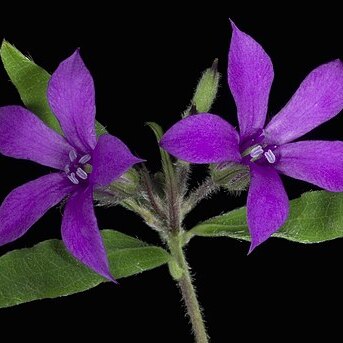Twiner with villous short shoots; heteroblastic and heterophyllic, displaying leaves from several developmental stages at the same time/persisting in adult stages. Seedling leaf stages ovate, 20–25 mm long, 9–11 mm wide, irregularly lobed, dentate, persistent; intermediate leaves similar dimensions but with entire but sinuate margins. Adult leaves sessile, narrowly elliptic, 15–20 mm long, 3–4 mm wide, entire, margin sinuate, apices recurving, yellow-green; adaxial surface glabrescent. Inflorescences sessile, multi-flowered, corymbose, villous; persistent bracts 2 mm, both surfaces dense villous, sepaline. Sepals 4–5.5 mm, both surfaces villous, green with purple striations. Petals 10–15 mm long, free, spathulate, apices recurving, deep purple at anthesis, fading bluer with age. Stamens free, filaments tapering, eventually purple; anthers much shorter than filaments, white, ovoid, basal lobes widely flared; pollen yellow. Pistil dense white hairy; minimal basal nectary; style very brief (
More
A slender, hairy plant. It climbs to about 3 m tall. The leaves are sword shaped and dark green. They have crinkled edges. They often have a black tip. The flowers are bright blue. They are 10-12 mm across. They have open spreading petals and are at the ends of branches. The fruit are small and green. They are fleshy and hairy berries.

